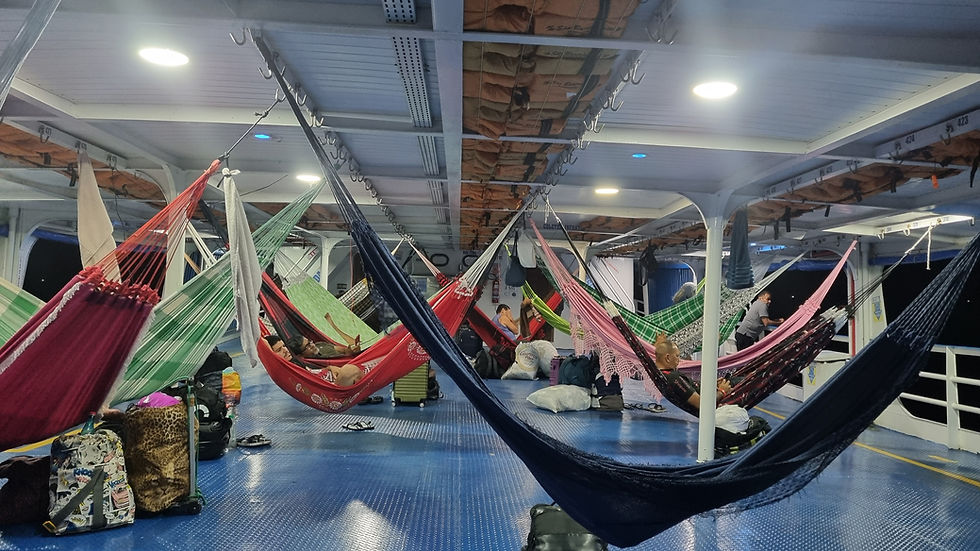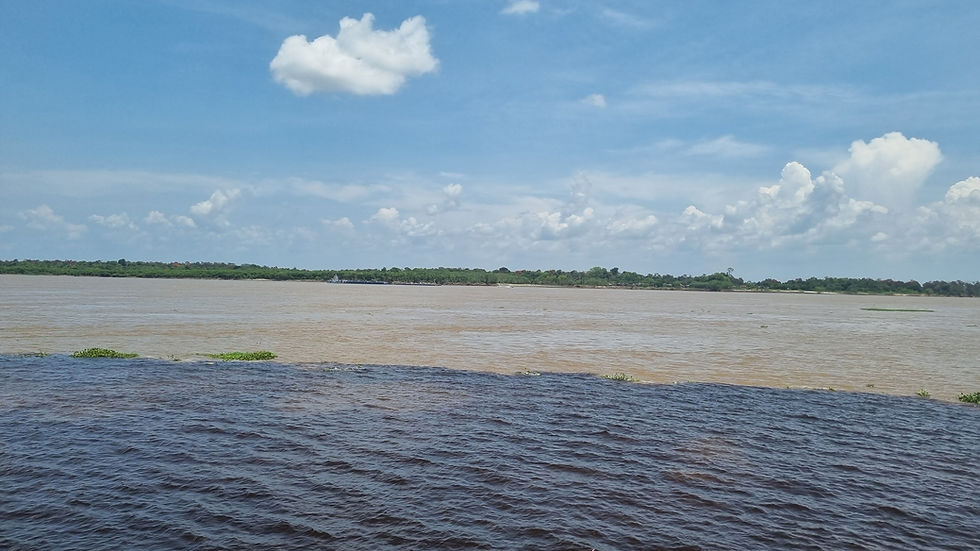12 incredible things to see and do in the Amazon Rainforest, Brazil
- Rachel

- 14 minutes ago
- 8 min read
The Brazilian Amazon is not a single destination but a vast region the size of a continent, stitched together by an immense network of rivers. Travelling here means entering a world where water is the main road, the main food source and the main link between communities. Instead of highways you move along waterways, passing floating houses, river islands, dense forest and open sandbanks. The experience is as much about the journey as the places themselves.
Three cities serve as the base for most travel in the Amazon Rainforest in Brazil. Manaus, deep in the state of Amazonas, is the largest and sits at the confluence of the Rio Negro and the Solimões. Santarem, farther east in Pará, stands where the Amazon meets the clear waters of the Tapajós. Belém, near the river’s mouth, is a historic port connecting the rainforest to the Atlantic. From these hubs you can board slow public ferries, fast catamarans or small launches to reach beaches, waterfalls, wildlife reserves and traditional communities.

Seasons shape what you can do. The wet season, from December to May, raises river levels and turns forest into navigable waterways where boats glide under tree canopies. The dry season, from June to November, exposes beaches, trails and pastures and makes cultural festivals easier to reach. Understanding this cycle allows you to plan a trip to Brazil's Amazon Rainforest by scheduling your trip for the season that aligns with the activities you would like to do.
1. Explore Brazil's Amazon Rainforest by Slow Boat

Best time: Dry season – riverbanks are more visible and stops at riverside communities are easier.
Taking the slow boat between Manaus and Santarém takes two to three days and is the main way people travel between the two cities. The boat continues on to Belem, taking another 2.5 days. You hang a hammock on deck, sleep alongside other passengers and watch the daily traffic of supply boats, fishermen and floating houses. The journey passes confluences, islands and communities that are invisible from a plane. It is possible to step off at intermediate ports, buy food from canoe vendors and see how the Rio Negro changes into the clearer Tapajós as you approach Santarém. Doing this trip gives a real sense of the scale of the Amazon basin and how people rely on its rivers.
2. Go to the Beach at Alter do Chão

Where: On the Tapajós River near Santarem, Pará.
Best time: Dry season – sandbanks emerge and beaches expand.
Alter do Chão sits on the banks of the Tapajós where you can find freshwater beaches with white sand and clear water during the dry season. You can cross by small boat to Ilha do Amor, swim, relax on the sand or paddle canoes up forest creeks. It is also possible to take day trips from the town to nearby riverside communities and small forest trails. Because the beaches appear only when water drops, the scenery changes each month, making it a unique Amazonian contrast to the image of dense jungle.
3. Boat Through Flooded Forests at the Anavilhanas Archipelago

Where: Rio Negro near Novo Airão, Amazonas.
Best time: Wet season – high water allows boats to enter forest channels.
The Anavilhanas Archipelago contains hundreds of islands in the Rio Negro. During the wet season the river rises and floods the forest, creating a labyrinth of channels. You can take a motorised canoe from Novo Airão or Manaus and glide through submerged trees where birds perch at eye level and fish swim among trunks. It is possible to stop on small islands, watch monkeys or paddle quietly to hear forest sounds. The combination of open water, flooded forest and wildlife makes it a key site for understanding seasonal change in the Amazon.
4. See Pink River Dolphins in Novo Airão

Where: Novo Airão, Amazonas.
Best time: Wet season – dolphins move into flooded channels and are more frequently seen.
Novo Airão is known for encounters with Amazon river dolphins (botos). Floating platforms on the Rio Negro make it possible to watch these animals surface and feed at close range. Local guides offer boat trips into side channels and lagoons where dolphins hunt fish and sometimes approach boats out of curiosity. It is also possible to combine dolphin watching with visits to the Anavilhanas islands, so you can see both the animals and their habitat. Spending time here gives a view of how aquatic mammals fit into Amazonian river life.
5. Swim in Waterfalls in Presidente Figueiredo

Where: Presidente Figueiredo, Amazonas, north of Manaus.
Best time: Dry season – trails are more accessible and natural pools calmer.
Presidente Figueiredo is an upland area with dozens of waterfalls. You can hike short forest trails to Iracema, Mutum, Pedra Furada, and many others, swim in natural pools and explore small caves. Because it sits on a plateau, the vegetation and geology differ from the lowland floodplain, offering another Amazonian environment. In the dry season trails are firm and water calmer, making it easier to combine several falls in a single day. It is best to base yourself in town and do day trips to different caves and waterfalls, but it's also possible take a day trip from Manaus.
6. See Buffalo at Marajó Island
Where: Marajó Island at the mouth of the Amazon near Belém, Pará.
Best time: Dry season – pastures are exposed and buffalo are easier to see.
Marajó Island is the world’s largest river island and has thousands of domesticated water buffalo. You can stay at rural lodges, ride buffalo on farm tracks or watch herds grazing on open grassland. It is also possible to explore mangroves, beaches and small towns with strong Afro-Indigenous traditions. Because the wet season floods large areas, the dry months make it easier to access farms and wildlife areas by road or horseback. Seeing buffalo here shows how human livelihoods adapt to Amazonian landscapes.
7. Learn Carimbó Dance
Where: Pará state, especially Belém and Marajó.
Best time: Dry season – cultural festivals and public performances are more frequent.
Carimbó is a traditional rhythm and dance of Pará with African and Indigenous roots. In Belém you can take workshops at cultural centres, or on Marajó you can join community events. It is possible to learn the steps, see live percussion and understand the stories behind the songs. Festivals during the dry season bring larger groups and traditional dress, creating a setting where you can participate rather than just watch. Including Carimbó in your trip adds a cultural dimension to a nature-focused itinerary.
8. See the Meeting of the Waters

Where: Confluence of the Rio Negro and Rio Solimões near Manaus.
Best time: Dry season – clearer colour contrast between rivers.
A short boat ride from Manaus takes you to the point where two rivers of different colours meet but do not mix for kilometres. You can watch the dark Rio Negro and the sandy Solimões flow side by side and feel the change in temperature between them. Tours often stop at floating houses, giant water lilies and small creeks so you can see how people live on this dynamic edge. Seeing this phenomenon explains why the Amazon River looks the way it does downstream.
9. Go Birdwatching
Where: Southern Amazon, Mato Grosso state (Cristalino) or remote Amazon Roosevelt area.
Best time: Dry season – trails and canopy towers more accessible and birds concentrated at water sources.
Cristalino Lodge and the Amazon Roosevelt region offer some of the richest birding in Brazil. You can climb canopy towers for views above the forest, take dawn boat trips and walk quiet trails to spot macaws, toucans, antbirds and other species. These lodges also have guides who can point out primates, butterflies and rare plants. Because the southern Amazon is a transition zone with the Cerrado, the mix of habitats is different from the central Amazon, giving another angle on biodiversity.
10. Shop at the Ver-o-Peso Market in Belém
Where: Belém, Pará.
Best time: Dry season – easier to walk outdoor stalls without heavy rain.
Ver-o-Peso is a vast riverside market dating back centuries. You can wander past stalls selling Amazonian fish, açaí, medicinal herbs, tropical fruits and handmade crafts. It is possible to sample local dishes like tacacá or maniçoba and see how products from remote regions reach the city. Early morning is the most active time, with boats unloading fresh goods from the islands and the smell of smoked fish and herbs filling the air.
11. See a show at the Amazonian Theatre in Manaus (Teatro Amazonas)

Where: Manaus, Amazonas.
Best time: Dry season – city walking tours and evening performances more comfortable.
The Amazonian Theatre is a symbol of Manaus’s rubber boom history. You can take a guided tour of its ornate auditorium, stage and museum, or attend concerts ranging from classical to regional music. The building sits in a central square with cafes and other attractions, making it easy to include in a day exploring the city. Seeing a performance here links the cultural history of Manaus with its modern life as the largest city in the Amazon.
12. Stay in a Jungle Lodge
Where: Various locations along tributaries and reserves across the Amazon.
Best time: Dry season – more trails open and wildlife viewing points accessible.
Staying in a jungle lodge lets you experience the forest over several days. You can take guided hikes, canoe trips, night excursions and canopy walks, and hear the rainforest at dawn and dusk. Lodges near Manaus focus on river life and flooded forest, while those in the southern Amazon emphasise birdwatching and research. Accommodation ranges from simple cabins to eco-lodges with solar power. This kind of stay gives time to adjust to the rhythms of the forest rather than just visiting on a day tour.
What to Bring to the Amazon Rainforest in Brazil
For hiking, hiking boots are needed if planning to do the more difficult multi-day treks. However, many day trips involve easy walks that can be done in flip-flops or regular closed walking shoes. Check with your guide ahead of time.
Sun protection, including a hat and waterproof sunscreen
An insulated water bottle for longer walks and day tours
A good insect repellent for mosquitos, particularly around dusk
It's a good idea to pack a rain jacket, even in the dry season
A waterproof bag for boat trips and trekking
A swimsuit to enjoy the waterfalls and rivers
A head torch for night treks
More resources for planning your trip to Brazil
Find cheap bus, ferry, and private transfer tickets on Bookaway, where you can make reservations ahead of time from abroad. Or, rent a car and give yourself the freedom to explore at your own pace.
Find your perfect accommodation on Booking.com, with thousands of options ranging from luxury hotels to budget-friendly backpacker hostels
You're not ready to travel until you have travel insurance. I recommend Safety Wing to my friends, family, and anyone travelling internationally. Get a free quote
Forgetting something? Read my packing check-list for Brazil, and my list of 10 things you should do before you travel to Brazil





Comments